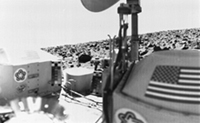
Viking 2 lands on Mars and begins transmitting pictures and soil analyses.
The Viking mission went to Mars to look for signs of life, study the soil and atmosphere, and take pictures. Viking 1 and Viking 2 descended to Mars within six weeks of each other. Viking 2’s landing was more dramatic than NASA might have hoped: as the lander separated and began to descend, the orbiter’s stabilization system went awry, blacking out for almost an hour.

The Viking landers were each approximately ten feet across and seven feet tall; they weighed roughly 1,270 pounds. Their descent engines were designed to disperse exhaust, in order to minimize disturbance of the landing sites. But a radar miscalculation caused Viking 2’s engines to fire briefly just before landing, cracking the planet’s surface.
Viking 2 performed a raft of experiments on the planet’s soil, seismology, atmosphere, meteorology, and possible biology. The Viking orbiters mapped nearly all Mars’s surface and observed Martian seasons. Neither Viking lander found significant amounts of water or ice, but both gave important information on Mars’s iron-rich clay and Martian wind and climate. Viking 2’s seismometer may even have recorded a Mars-quake, and both landers observed dust storms—local and global.
The spacecraft were rated for ninety days’ work, but they kept going and going. Viking 2’s orbiter sprang a leak and was shut down in 1978. The lander’s batteries died in 1980. (Viking 1’s lander worked until 1982.)
Recent analyses of crater impacts have shown that if Viking 2 had dug just three or four inches deeper, it would have discovered ice deposits, confirming the existence of large amounts of water on the planet decades sooner.—JBJ